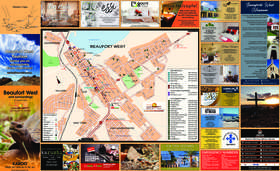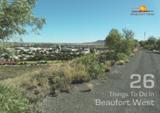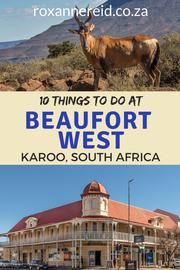Nelspoort
Nelspoort is a small community in the depths of the Central Karoo. The Bushmen and Khoi visited the surrounding koppies and left their mark in rock engravings. Later white farmers established their homes here and for a time the Sanatorium brought peace and healing to many TB sufferers.
Today the community welcomes visitors who come to see the ancient relics of longlost peoples, the Karoo plants and the game which is farmed in the district and to enjoy the clear air and brilliant night skies.
The Bushmen And Their Art
In time gone by, the indigenous Bushmen were the only people who lived around what is now Nelspoort. Their chosen shelter was benign Tierkloof, where the wilderness winds of the Great Karoo only whisper during the harsh winters.
The Bushmen are long gone, but here you can still create mind images of them sitting in the warmth of the winter sun chattering in their strange clicking language as they fashioned hunting implements, pierced ostrich shells for necklaces or drilled holes into round rocks. These provided leverage for digging sticks, essential implements in the arid environment of the Karoo where plant roots were a delicacy. Today, the remains of these curious stones are occasionally still found on the veld.
From the engravings of real and dream animals they left on the rocks one gets the feeling that the Bushmen were happy at Tierkloof. One shows a strange creature with wide horns like an ox which might be a Megalotragus, a bovine extinct for 10 000 years - or perhaps Pelorovis antiquus the extinct giant buffalo thought to have become extinct about 7 000 years ago - or perhaps it is a Spirit World animal? With conservation in mind, permission must be obtained to visit the Nelspoort Rock Art sites.
Birds and creatures with bird forms are depicted in many of the engravings, which, say experts, indicate that a shaman once lived here.
For more on the rock art of Nelspoort click here.
The Peal Of Stone Bells
Other Bushmen relics in the area include a kraal and several rock gongs. These were fashioned from portions of dolerite or ironstone, then expertly positioned on high ground to produce differing tones when struck with smaller pieces of ironstone. The notes resemble the peal of church bells. Sven Ouzman of the Anthropology Department at the University of California at Berkeley, who has done research into the sites at Nelspoort, says that "Gong rocks were used to imbue sites with a spiritual atmosphere and to help induce altered states of consciousness".
A Place Of Healing - The Nelspoort Sanitorium
A long time after the Bushmen, the area became a haven for those with chest ailments. As early as 1836, Beaufort West’s dour, but well-loved Dr John Christie appealed to people to "breathe the air of the Nuweveld Mountains". Then, as far back as 1850, the famous explorer David Livingstone extolled the climate of the Karoo and noted it was "suitable for all patients with pulmonary complaints". Victorian medical men, like Dr Hermann Weber and Mr John Noble of the Army Medical Corps, agreed. Weber declared it ideal for phthisis patients, while in 1878, Noble recommended the area for "invalids".
The Wages Of Poverty
The Nelspoort Sanatorium story actually has its beginnings in Cape Town. When Dr Alfred Jasper Anderson was appointed medical officer of health for Cape Town in 1881, he was appalled by the health hazards of the city’s slum areas. The enormous death rate due to a variety of respiratory and other diseases caused by extreme poverty shocked him, but the government of the day turned a blind eye. Worse was to come. During the Anglo-Boer War plague broke out in Cape Town and rampaged through the slums. There was no alternative but to demolish huge areas However, living conditions simply worsened, quality of life deteriorated and poverty and malnutrition increased in these abject circumstances as disease spread.
Tuberculosis was rampant, and the death rate soared. Yet there was continuous news of miracle cures being achieved in the Karoo. Cape Town doctors decided to investigate. They discovered many who swore breathing the fresh, clear, crisp air had cured their ailments. By 1850, so many miracle cures had been reported "back home" that chest sufferers were flocking to the Karoo. Matjiesfontein, Beaufort West and the Nuweveld Mountains drew hundreds of them.
Sadly, many had left it too long and were already far beyond help by the time they arrived, as church burial registers testify. Meanwhile, conditions became so bad in Cape Town that Dr Anderson established the Society for the Prevention of Consumption in the hopes of receiving government aid. But this was not forthcoming. He would have to wait to meet philanthropist John Garlick, before his dreams would become a reality.
In Search Of A Miracle
In 1889, Dr E Symes-Thompson, of the Royal Colonial Institute of London, visited South Africa. Having heard of the Karoo climate he travelled into the interior towards the Nelspoort area to experience it at first hand. He was highly impressed and he too praised the health-giving air. He attributed its healing qualities to "excessive dryness of air and soil", "remarkable purity and coolness", and "absence of dust." He immediately reported his findings to the British medical fraternity. "We also found at a level of less than 1 000 m above sea level an almost complete absence of floating matter, great intensity of light and solar influence, great stillness in winter, large amounts of ozone and a degree of rarefaction which has proved of value in the treatment of phthisis." Dr James Alexander Mitchell, who had been sent to South Africa by Lord Lister to work at the leper colony on Robben Island, endorsed his findings.
Philanthropist Steps In
Then in 1911, philanthropist John Garlick, founder of one of the country’s leading departmental stores, joined Dr Anderson’s Society for the Prevention of Consumption. Garlick was appalled at the toll tuberculosis was taking, particularly in the Cape Coloured areas such as District Six. The death rate terrified him, and he vowed to "stem this dreadful tide."
Thomas Mann’s novel "The Magic Mountain", which tells of a sanatorium in the Alps, convinced him such a place could be created in the Great Karoo. Garlick immediately set about turning the dream into reality. In 1918, he donated £25 000 to Dr Anderson’s cause on condition the Cape Municipal Association donated a similar amount and that the funds be used to establish an institution for consumptives.
Beyond His Dreams
Anderson was delighted. The estimated cost of such an establishment was £75 000, and to receive one third of the amount in a single donation was far beyond what he had hoped for. Garlick’s gesture was supported by key men such as Josiah Robert Finch, Town Clerk of Cape Town, the Administrator, Sir Frederick de Waal, Minister of Health, Sir Thomas Watt, Dr Mathew Hewat of the Hospital Board, and Dr H Shawe, Secretary for the Interior. Churchmen, such as Bishop Welch and Bishop Lavis, also pledged support and donations poured in. The sum of £50 000 was received from Parliament, Cape municipalities and mining houses, such as De Beers, contributed and soon more than £108 000 was raised for "the first chest hospital on the African Continent".
Search For A Site
The search for a suitable location began. Places such as Cradock, Graaff-Reinet, Mortimer, Matjiesfontein, Touws River, Fraserburg Road now (Leeu Gamka) and Beaufort West, were evaluated.
Eventually it was decided that an 8 154 morgen farm in the Salt River area of the Nuweveld Mountains, 40 km north of Beaufort West, would be ideal. It had a railway station and an excellent supply of water. The land was fertile, and much had already been planted to lucerne. There were orchards, gardens and sufficient grazing for cattle and sheep. And the price was right. It was acquired for only £17 800.
Top Man Appointed
Dr Peter Allan, of Romsley Hill Sanatorium, Birmingham, was appointed as the first resident medical superintendent. He was a highly skilled man and his appointment was regarded as a coup. Mr Basson was appointed to manage the farm, which was to provide fresh fruit and vegetables for the patients. The first arrived on May 5, 1924, and by December, that year, the sanatorium was treating 65 patients. Results were excellent. Good food, rest and fresh air were creating the miracles everyone had hoped for.
More and more VIPs began to visit the sanatorium. So the South African Railways seconded its head gardener, Mr H Hall, to lay out a garden, rock garden and plant flowering trees. However, it was not a case of love at first sight for everyone. One American is said to have stepped from the train at noon on a blistering day and exclaimed: "Lord, what a wilderness, what a ghastly wilderness." Hospital staff told him, if he returned later, after the rains, he might soften his views.
A Prince Opens The Doors
The Prince of Wales, later Edward VIII and then Duke of Windsor, passed through the Karoo on his official tour of South Africa in July, 1925. He stopped at Nelspoort on July 24 to perform the official opening of the Nelspoort Sanatorium.
The prince used a gold key, a gift to him, to unlock the door to the administration block. And, to mark the occasion, he planted the first of a small grove of blue gum trees. These had been grown from seed especially imported from Australia. Then, as the weather was excellent, the prince and his party were swept off to enjoy traditional Karoo hospitality at a picnic in the healthy air. That night almost all dozed happily on the Royal White Train. Their eyes shone and their skins were pinkly tinged from a day in the open under the Karoo sun, but they declared themselves "totally contented after a thoroughly enjoyable outing".
The blue gums flourished. They are particularly handsome trees with dark olive leaves. This is the only place in South Africa where this species has established itself. From time to time, since 1983, experts have been sent to Nelspoort to harvest the seed so that more of this species can be cultivated for planting in other parts of the country.
More Royals Call
While in South Africa in 1947, the British Royal family visited the Nelspoort Sanatorium. There were received by Dr Hendrik Reinhardt Ackermann, Medical Superintendent, and shown the facilities for the 460 patients then being treated. He explained some of the innovative treatments being used, such as gold injections, and pneumo-thorax techniques, during which a lung was compressed for six to nine months or longer to allow it to rest. By then the sanatorium had a small power station and a cinema entertainment centre. Patients were also taught a variety of skills and crafts. For many years, John Garlick, the Nelspoort Farmers’ Association and other benefactors, such as the Red Cross, provided Christmas treats for the patients.
By 1969, the first psychiatric patients were admitted. The disastrous socio-economic effects of tuberculosis had decreased by then and the disease could be treated at home with drugs. The old magic mountain method of healing with good food and fresh air was a thing of the past. So, Nelspoort devoted itself to psychiatric patients, maintaining only one TB ward. Today both roles have declined.
Powerful Historical Links
Little Nelspoort has oddly strong links with top men of South African history. In the mid-1800s, a young English adventurer, later knighted, came to South Africa in search of his fortune, which he thought was to be found in farming. After working in Cape Town as a librarian, John Charles Molteno became a wool trader in the Karoo and acquired a farm at Nelspoort. By the time he was elected to the Cape Parliament in 1854, he owned huge estates in the area. A champion of responsible government and known as "the Lion of Beaufort West", he went on to become the Cape Colony’s first Prime Minister in 1872. Molteno introduced the first Saxon Merino sheep to the Karoo and they did well at Nelspoort, which one writer of the day referred to as "healthy for both man and beast".
Jacob, a nephew of Abraham le Clercq on whose farm Beaufort West was established, farmed at Klipkraal which became part of the sanatorium grounds. The original farmhouse and outbuildings still stand. In early years post coaches stopped here for fresh horses and to allow passengers to refresh themselves. There was a smithy to shoe horses and the farm provided stabling for 16 horses. Eventually, John Lamb, a travelling Mosenthal salesman, settled there. In a letter home he mentions a drought during which his friend Blyth at Beaufort West lost "thousands of sheep," while he and his neighbours at Nelspoort were not badly affected at all. A visiting Mosenthal colleague was not enamoured of the area. He found Nelspoort "a desert wilderness among mountains and stones. There is only one advantage to living here", he said, "and that is that passers-by pop in for a chat. This is a real relief, as the Dutch who live here have shocking little to say". Somebody once also said " it takes all kinds!"
The Boer War And Kitchener’s Well
Nelspoort has links with the Anglo-Boer War. In 1901, in an effort to prevent the northbound rail link from being destroyed, the British built hundreds of blockhouses. Two were erected to guard the bridges over the Krom River, near Nelspoort. In 1980, however, one was totally destroyed in a flash flood. The other still stands in the shade of pepper trees on the farm Smokey Grove. Guard posts and schantzes were also built on the Nelspoort koppies and soldiers were garrisoned nearby to man the lookouts and blockhouses. Their water source was a perennial fountain, to this day, called Kitchener’s Well after Lord Kitchener, British Commander-in-Chief.
Attack On A Train
There was a skirmish just north of the settlement on July 20, 1901, when Boer forces captured a train at Ganna Siding. Three British soldiers, Sgt A M Geary, of the Cape Colony Cycle Corps; Trooper J Welsh, of the S A Light Horse, and Trooper A J Farmer, of the Imperial Yeomanry, were killed. They are buried behind the old post office, near the station.
A Boer soldier, Hendrik Johannes Botha, from Cradock, was shot in the stomach and also died and was buried at Kruidfontein. In the 1960s, changes along a gravel route necessitated his re-interment in Murraysburg.
Two Imperial Yeomanry Troopers, A Lynn-Smart and Francis White, were wounded, but later died and were buried in Beaufort West.
Two civilians received awards for bravery. One was the stoker of the train, Mr A Rabolini, who ran to Courlandskloof farm for help. The other was the engine driver, who refused to leave his post and so made it impossible for the Boers to move the train. These men were each given £10, a gold watch and commended by the British for their bravery. Their "stirling action in a time of extreme danger" was praised in the Press.
On A Lonely Hill, Far From Home
On a massive boulder high on a Nelspoort koppie a Swedish poem is engraved that tells of a great longing for home. At the top of what has become known as Petersen’s Kop on Courlandskloof, is also a silhouette of Petersen, a man who climbed this hill every day for two weeks to complete this unusual engraving. According to Reverend Paul de Villiers, of Beaufort West, who once lived on this farm, Petersen came to the Karoo with a chest ailment. "He was given a job on Courlandskloof as a teacher. He loved the Karoo, but missed his homeland. Petersen knew he was dying, so he decided to leave a little piece of Sweden on the rocks of the Karoo. It was a tremendous undertaking for a man so ill, but he completed it and died shortly afterwards." The silhouette above the verse is superbly executed. Translated into English in 1917 by a friend of Rev De Villiers’s father, the verse reads:
When the moon sheds its rays,
Like a silver cover on the Earth,
I then always ask these rays
to bring greetings home to the North.
Macabre Secrets Of The Rocks
Among Nelspoort’s rocks is a particularly grisly one depicting a man on the gallows. Under the engraving are the words: Wiese, Murder, 1865 and the initials IB. This macabre drawing intrigues archaeologist David Morris, of Kimberley’s McGregor Museum. Despite much intensive research, however, he has failed to find out whether "Wiese" was the murderer or the murdered man. Nor has any light been shed on the significance of the initials IB.A Long Walk North
Nelspoort’s police station sees many travellers along the north-south route. A few years ago, police officers walking from Pretoria to Cape Town to raise funds for the Cancer Foundation called there, but they were not its first long-distance walkers. In 1928, Nelspoort police station hosted J Hunter Wilson and Ronald A Monson, who were walking from Cape Town to Cairo "for fun"!
They wrote of a delightful time spent with a Nelspoort police sergeant who strode out to meet them, entertained them, kept them up till the "small hours playing billiards and talking of his experiences". The next day, he was up bright and early to walk halfway to Victoria West with them. "And", wrote Ronald Monson, "if you’ll pardon the pun, this hospitable and totally delightful fellow took the long walk through the Karoo in his stride".







